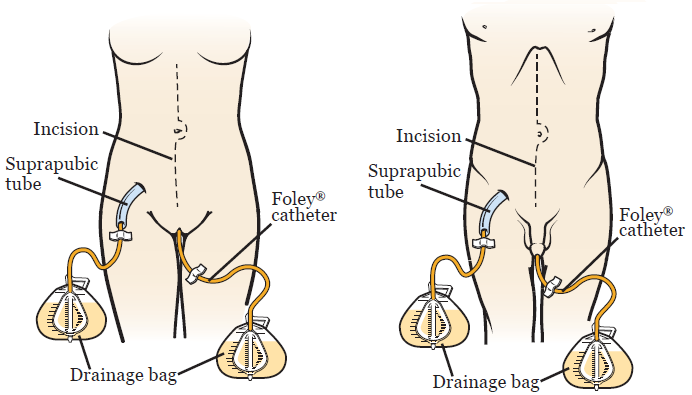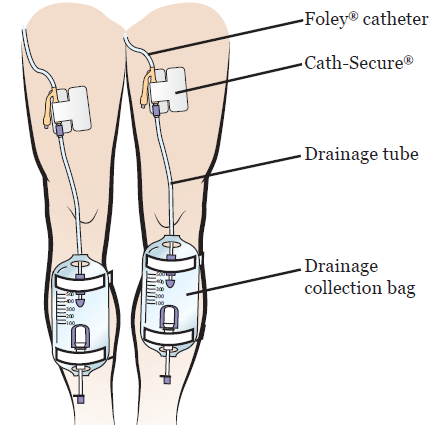This information explains how to irrigate (wash out) your ileal neobladder.
About Your Ileal Neobladder
A neobladder is a bladder made from a piece of your intestine. It allows your body to empty urine (pee) through your urethra.
However, a neobladder does not function the same way a natural bladder does. After surgery neobladders have 2 catheters (thin tubes) that drain urine and help your body heal. One of the catheters is a Foley® catheter, which drains urine by going through your urethra and into your neobladder. The other catheter is a suprapubic tube that goes from your lower abdomen (belly) into your neobladder (see Figure 1).

Figure 1. Female anatomy (left) and male anatomy (right) with suprapubic tube and Foley® catheter
Your urine will drain into bags attached to the catheters. During the day, your drainage bags can be attached to your legs so you can move around more easily. You will need to empty these bags every 2 to 3 hours. At night, connect the catheters to the large drainage (night) bag with Cath-Secures® or tape. This will allow you to sleep through the night without having to empty your bags. You should have urine draining into both bags or 1 bag. If you have no urine draining from either bag, call your healthcare provider.

Your neobladder was made from a piece of your intestine and your intestines create mucus. This mucus can buildup and block your catheters. To prevent this, you will need to irrigate the catheters in your neobladder.
Before you leave the hospital, your nurse will give you enough supplies for the irrigations to last until your catheters come out. You will also be given the names of supply sources to order the equipment in case you need more.
Self-Irrigation Instructions
You will need to do self-irrigations 4 times a day unless otherwise instructed by your healthcare provider. If you feel any pressure, pain, or bloating in your abdomen, try irrigating your catheters to relieve any mucus that may be causing these symptoms. If this doesn’t help, call your healthcare provider.
- Clean your hands. If you’re washing your hands with soap and water, wet your hands, apply soap, rub them together thoroughly for 15 seconds, then rinse. Dry your hands with a disposable towel, and use that same towel to turn off the faucet. If you’re using an alcohol-based hand sanitizer, be sure to cover all of your hands with it, rubbing them together until they’re dry.
-
Gather your supplies on a clean surface. We recommend using a portable table, such as a TV dinner table. You will need:
- 1 (60 mL) syringe
- Normal saline
- A small container
- If your drainage bags are filled with urine, empty them out into the toilet.
- Open the bottle of saline.
- Remove the plunger from the syringe.
- Sit down in a chair and recline your body at a 30 to 45 degree angle.
- Put the syringe down on the clean surface and disconnect your suprapubic tube from the drainage bag.
- Attach the syringe to the suprapubic tube.
- Pour 60 mL of saline into the top of the syringe. Raise the syringe and tube straight up to let the saline go through the tube.
- After the saline drains into your neobladder, remove the syringe and reconnect the suprapubic tube to the drainage bag. Watch to see if the saline comes through the tube into the drainage bag. You will most likely also see some mucus. This is called gravity irrigation.
- If the saline drains through the suprapubic tube immediately, repeat steps 8 through 10 one more time. You are now finished irrigating your suprapubic tube and can go to step 17 to irrigate your Foley catheter.
- If the saline does not flow through the suprapubic tube, you probably have a mucus blockage. If there is still saline in the syringe, empty it into the small container and flush it down the toilet.
- Put the plunger back into the syringe and pull up 30 mL of saline. If necessary, put the syringe down on a clean surface.
-
Disconnect the drainage bag from the suprapubic tube. Place the tip of the syringe into the suprapubic tube. Very gently push the saline into the tube. This is called flushing.
- If you are not able to gently push down, do not force it and move onto step 17 to try irrigating your Foley catheter.
-
Pull back on the syringe. This is called aspiration. You will probably see some mucus mixed in the saline in the syringe.
- If you are able to aspirate your suprapubic tube, empty the syringe into the small container and flush the contents down the toilet.
- If you are not able to gently pull back on the syringe during aspiration, do not force it. Remove the syringe and reconnect the suprapubic tube to the drainage bag. Get up and walk around; you will probably see the drainage mixed with mucus flow from the suprapubic tube at this time.
- If you are able to aspirate and flush your suprapubic tube, do so one more time. Then reconnect the drainage bag to the suprapubic tube. If you still can’t flush the suprapubic tube, move on to step 17 to try to irrigate your Foley catheter.
- To irrigate your Foley catheter, follow steps 5 through 15. You can use the same syringe to irrigate both the Foley catheter and the suprapubic tube.
- If you weren’t able to irrigate, flush, or aspirate one or both of the tubes, return to step 10 and try gravity irrigation again. You should see better results this time. If you do not, call your healthcare provider.
- You can reuse the same syringe for your next irrigation. Clean the syringe after each use by pulling the plunger out of the syringe and washing both with warm water and soap. Let them air dry on a clean surface.
- Clean your hands following the instructions in step 1.
Caring for Yourself at Home
- Drink 8 (8-ounce) glasses of non-caffeinated liquids per day.
- Do not drink any alcohol until your catheter has been removed.
- Do not cover the suprapubic tube with a dressing unless there is drainage around the tube.
- Get up to walk at least 3 times a day. You should be walking the same amount or more than you were in the hospital.
For information about caring for catheter, ask your nurse for the resource Caring for Your Urinary (Foley) Catheter.
Call Your Healthcare Provider If You:
- Cannot flush the tube or catheter
- Do not get drainage from your tube or catheter after irrigation
- Have no urine draining from either bag
-
Feel pressure, pain, or bloating in your abdomen after irrigation
- Try to irrigate first to relieve any mucus plug that could be causing these symptoms.
- Have a fever over 100.5° F (38.1° C)
- Have pus leaking from your incision (surgical cut)
- Have redness around your incision
- Have foul-smelling urine
- Have nausea (feel like throwing up) with vomiting (throwing up)
- Have any unexpected, unexplained problems
- Have any questions or concerns